Class 11: Maths Chapter 1 solutions. Complete Class 11 Maths Chapter 1 Notes.
Contents
Maharashtra Board Solutions Class 11-Arts & Science Maths (Part 2): Chapter 1- Complex Numbers
Maharashtra Board 11th Maths Chapter 1, Class 11 Maths Chapter 1 solutions
Ex 1.1
Question 1.
Simplify:
(i) √-16 + 3√-25 + √-36 – √-625
Solution:

= 4i + 3(5i) + 6i – 25i
= 25i – 25i
= 0
(ii) 4√-4 + 5√-9 – 3√-16
Solution:

Question 2.
Write the conjugates of the following complex numbers
(i) 3 + i
Solution:
Conjugate of (3 + i) is (3 – i).
(ii) 3 – i
Solution:
Conjugate of (3 – i) is (3 + i).
(iii) √-5 – √7 i
Solution:
Conjugate of (√-5 – √7 i) is (√-5 + √7 i).
(iv) -√-5
Solution:
-√-5 = -√5 × √-1 = -√5 i
Conjugate of (-√-5) is √5 i
(v) 5i
Solution:
Conjugate of (5i) is (-5i).
(vi) √5 – i
Solution:
Conjugate of (√5 – i) is (√5 + i).
(vii) √2 + √3 i
Solution:
Conjugate of (√2 + √3 i) is (√2 – √3 i)
(viii) cos θ + i sin θ
Solution:
Conjugate of (cos θ + i sin θ) is (cos θ – i sin θ)
Question 3.
Find a and b if
(i) a + 2b + 2ai = 4 + 6i
Solution:
a + 2b + 2ai = 4 + 6i
Equating real and imaginary parts, we get
a + 2b = 4 …..(i)
2a = 6 ……(ii)
∴ a = 3
Substituting, a = 3 in (i), we get
3 + 2b = 4
∴ b = 12
∴ a = 3 and b = 12
Check:
For a = 3 and b = 12
Consider, L.H.S. = a + 2b + 2ai
= 3 + 2(12) + 2(3)i
= 4 + 6i
= R.H.S.
(ii) (a – b) + (a + b)i = a + 5i
Solution:
(a – b) + (a + b)i = a + 5i
Equating real and imaginary parts, we get
a – b = a ……(i)
a + b = 5 ……(ii)
From (i), b = 0
Substituting b = 0 in (ii), we get
a + 0 = 5
∴ a = 5
∴ a = 5 and b = 0
(iii) (a + b) (2 + i) = b + 1 + (10 + 2a)i
Solution:
(a + b) (2 + i) = b + 1 + (10 + 2a)i
2(a + b) + (a + b)i = (b + 1) + (10 + 2a)i
Equating real and imaginary parts, we get
2(a + b) = b + 1
∴ 2a + b = 1 ……(i)
and a + b = 10 + 2a
-a + b = 10 …….(ii)
Subtracting equation (ii) from (i), we get
3a = -9
∴ a = -3
Substituting a = – 3 in (ii), we get
-(-3) + b = 10
∴ b = 7
∴ a = -3 and b = 7
(iv) abi = 3a – b + 12i
Solution:
abi = 3a – b + 12i
∴ 0 + abi = (3a – b) + 12i
Equating real and imaginary parts, we get
3a – b = 0
∴ 3a = b …..(i)
and ab = 12
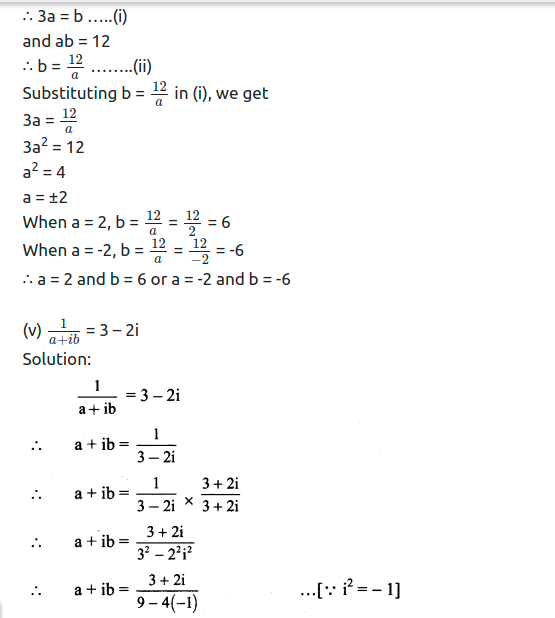

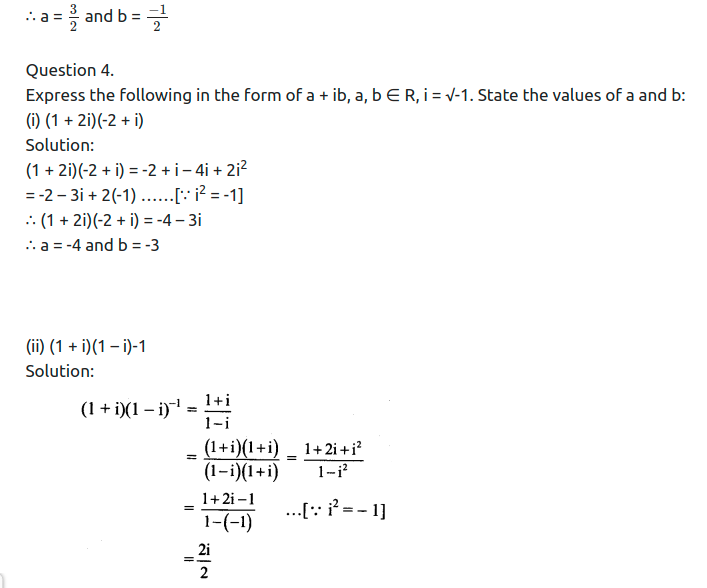
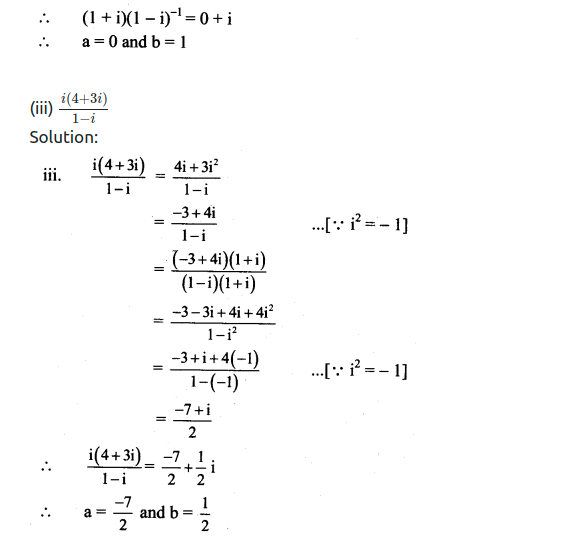
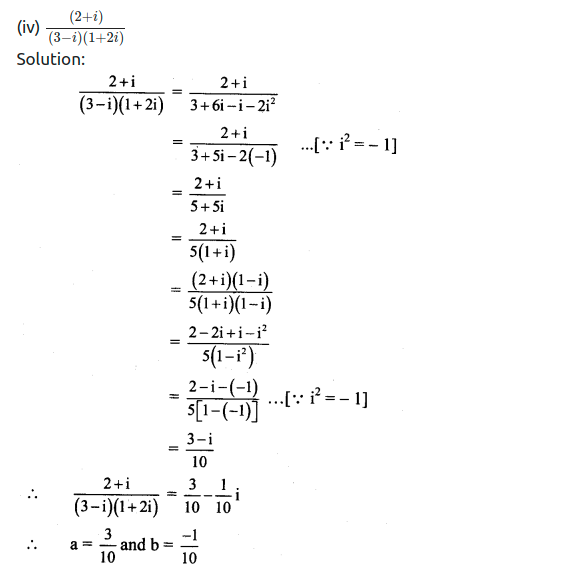

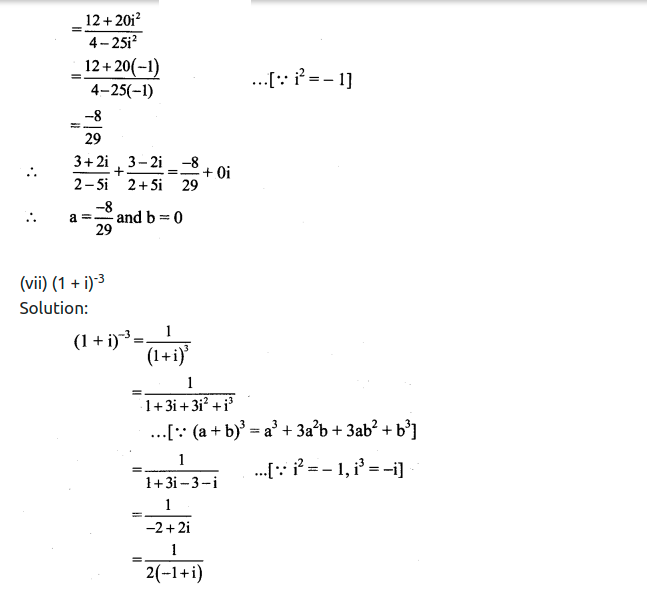
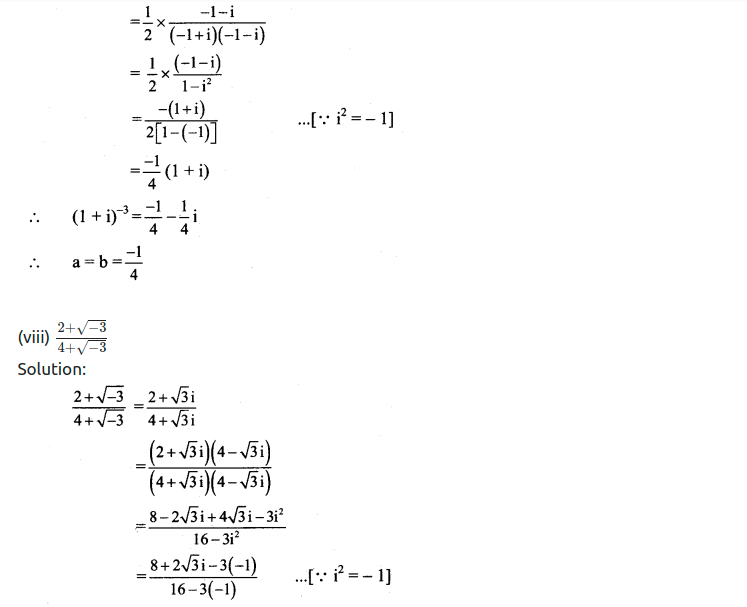
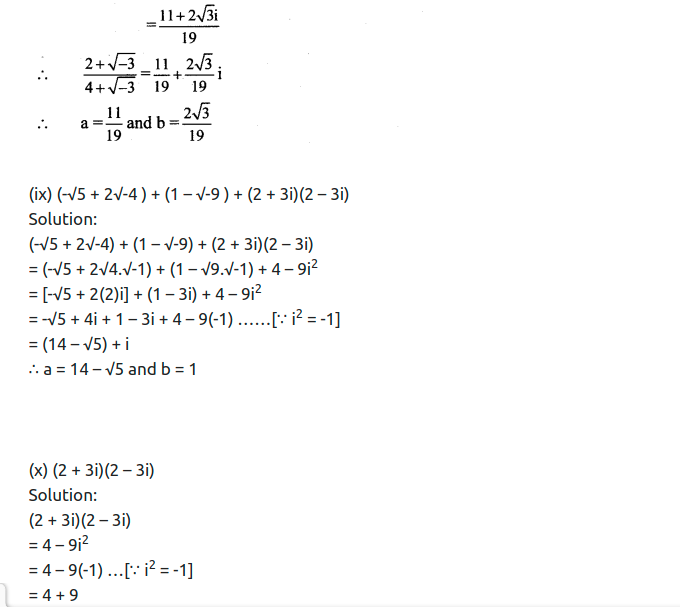


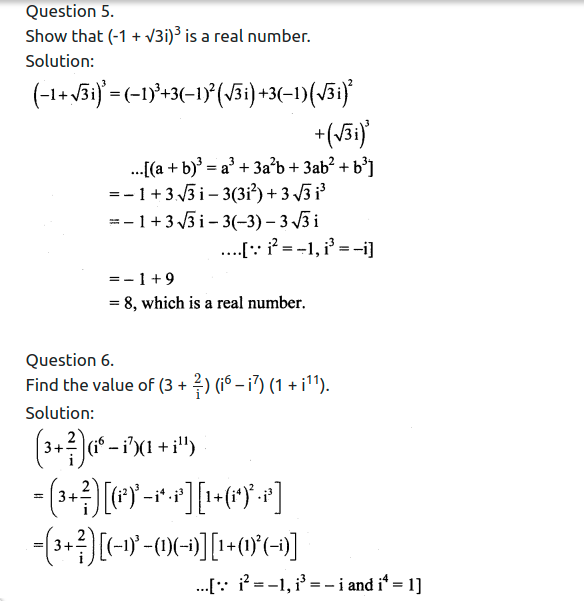
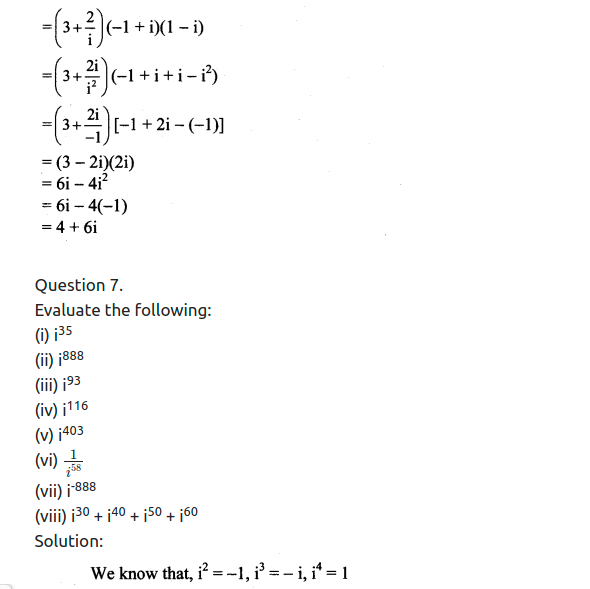
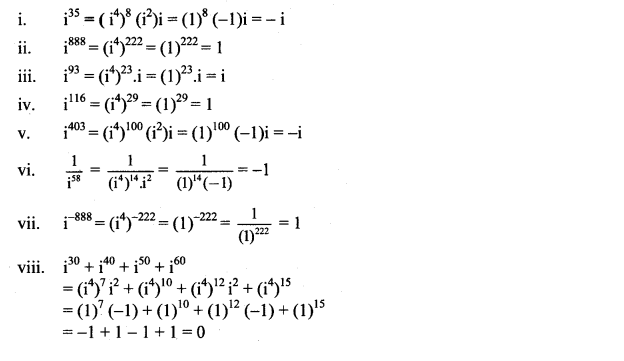
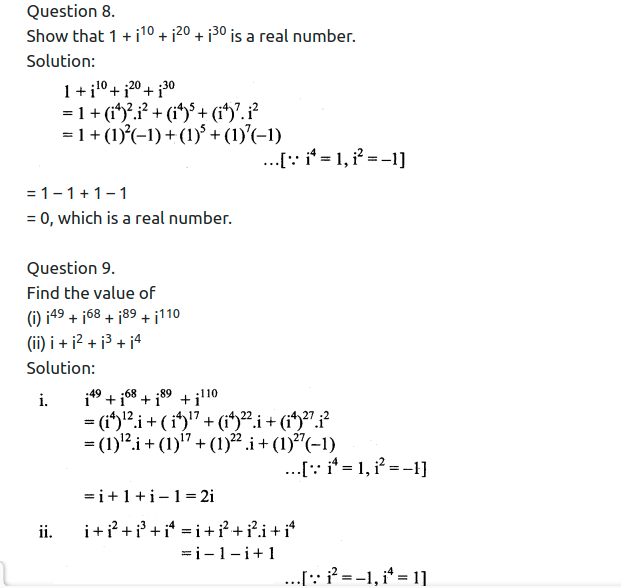
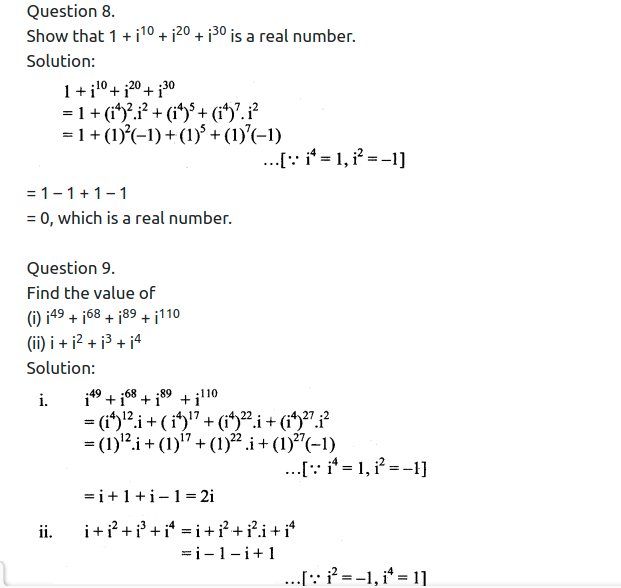
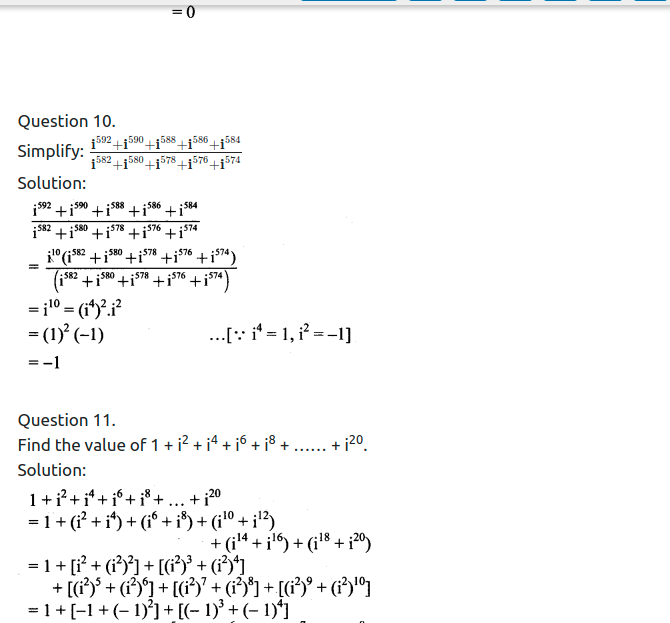

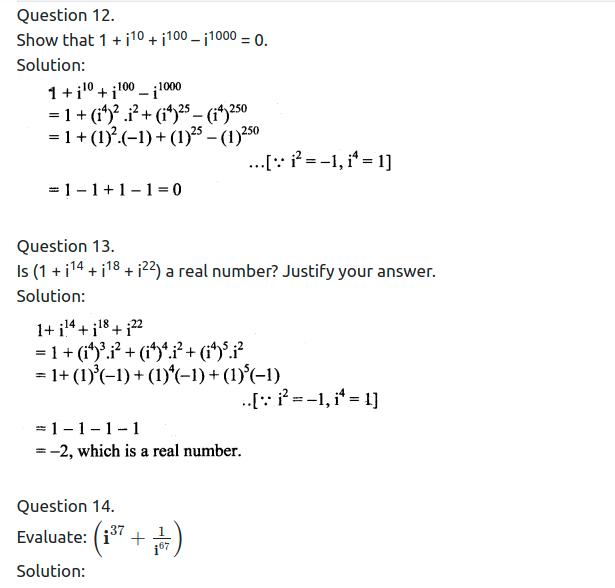
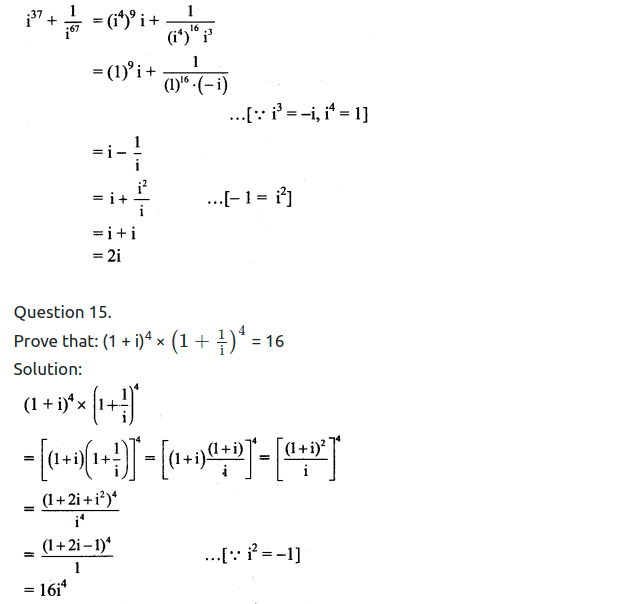

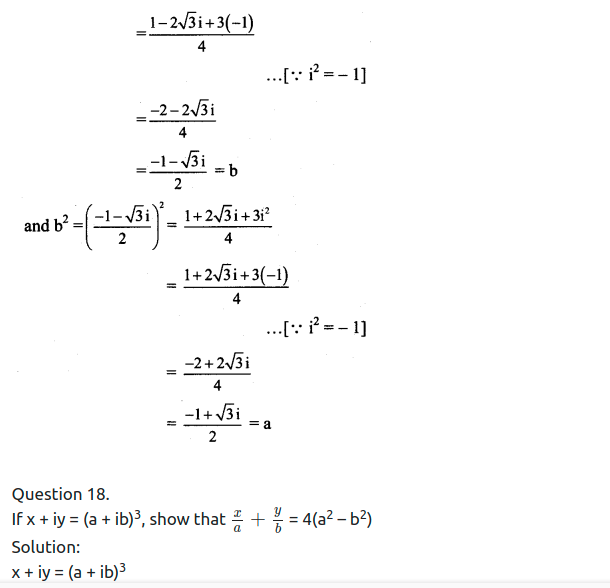
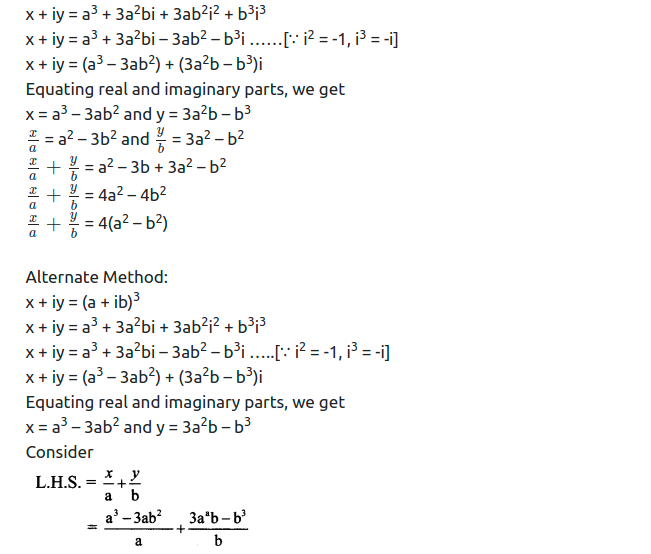
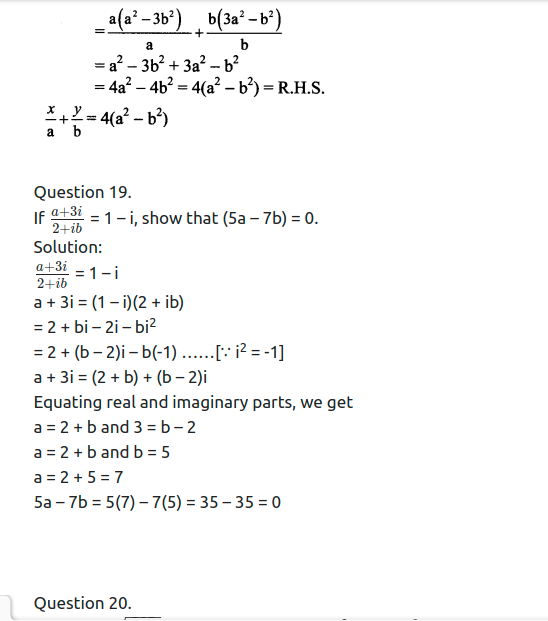
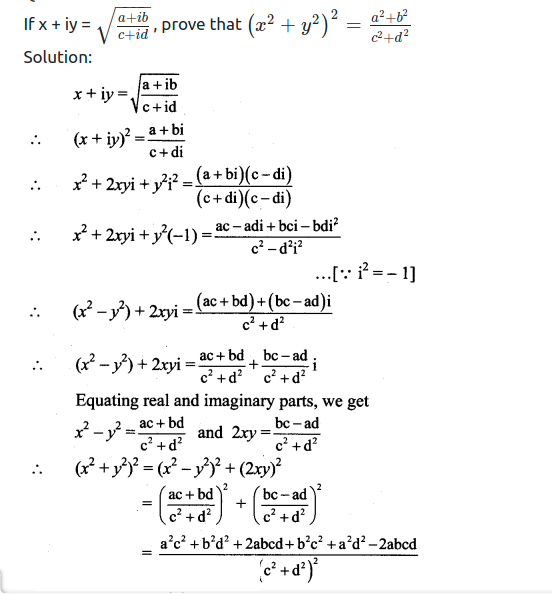
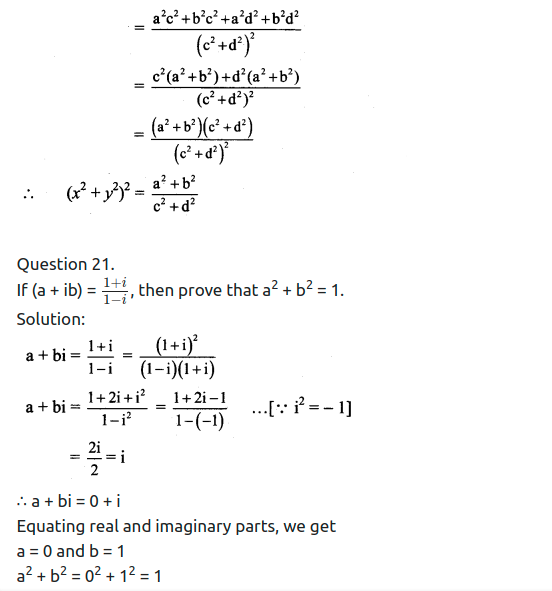
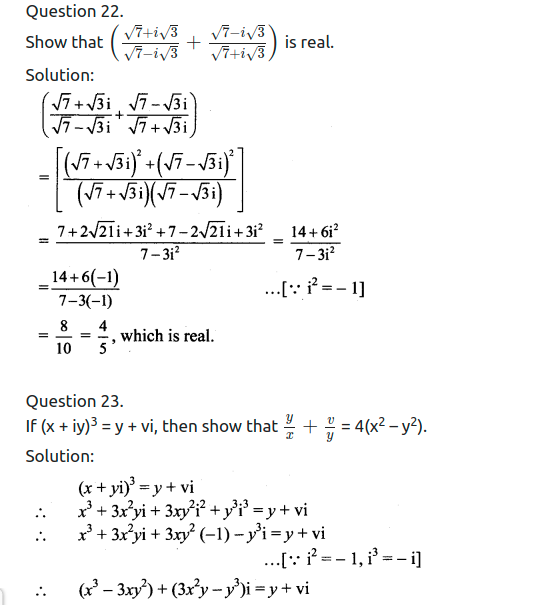
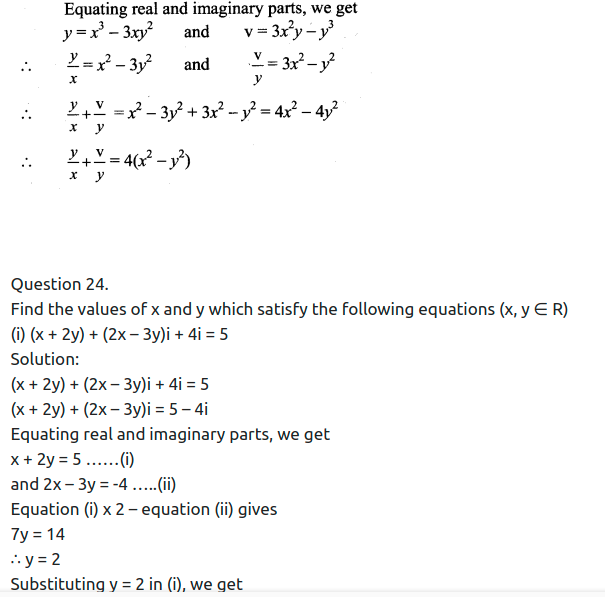
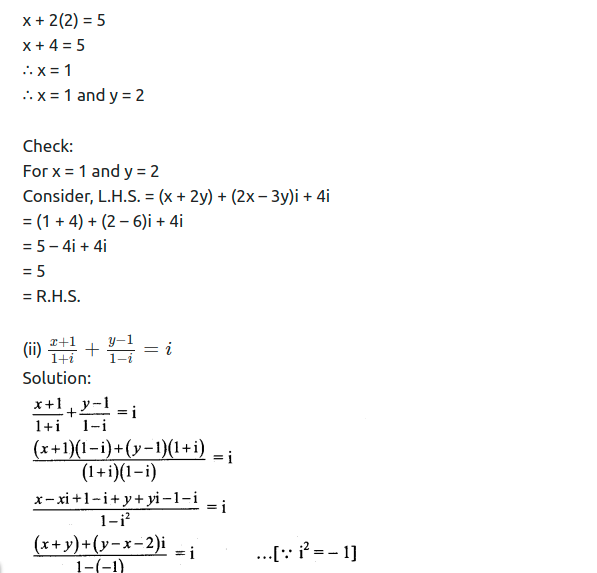
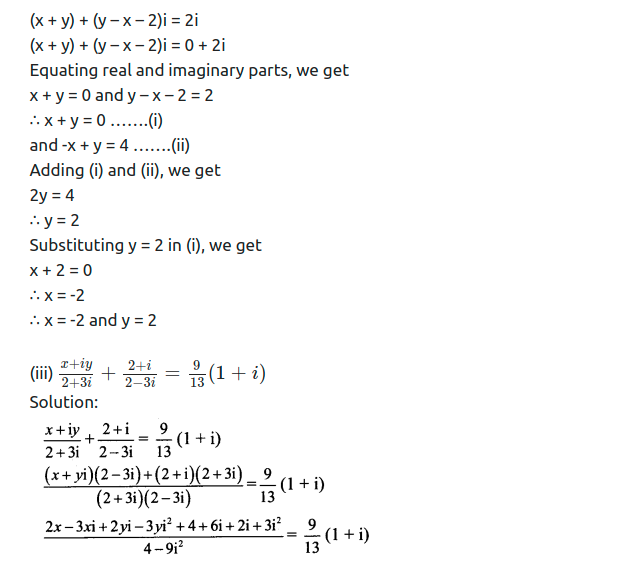
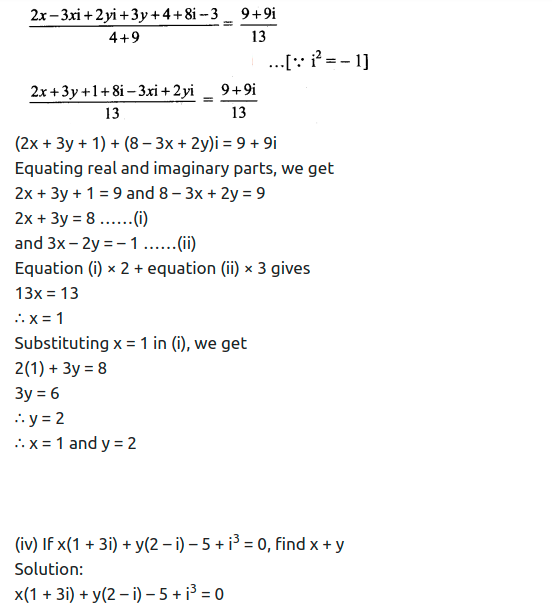
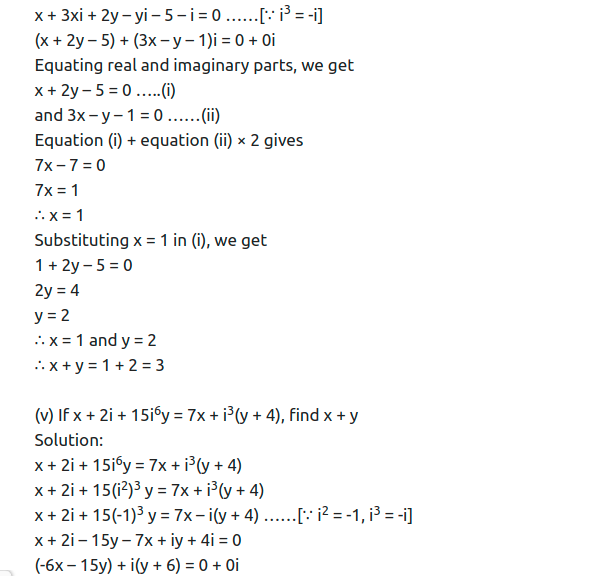
Equating real and imaginary parts, we get
-6x – 15y = 0 and y + 6 = 0
-6x – 15y = 0 and y = -6
-6x – 15(-6) = 0
-6x + 90 = 0
∴ x = 15
∴ x + y = 15 – 6 = 9
Ex 1.2
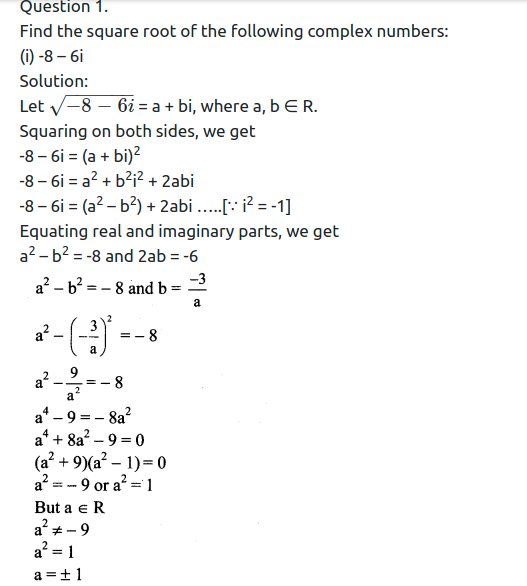

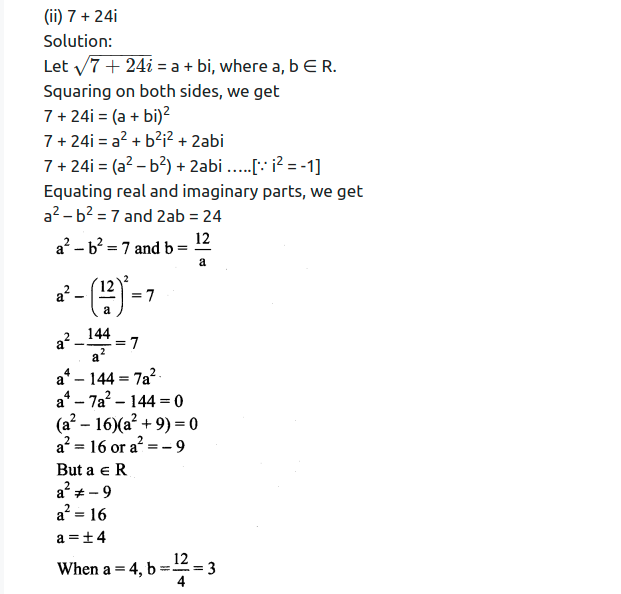
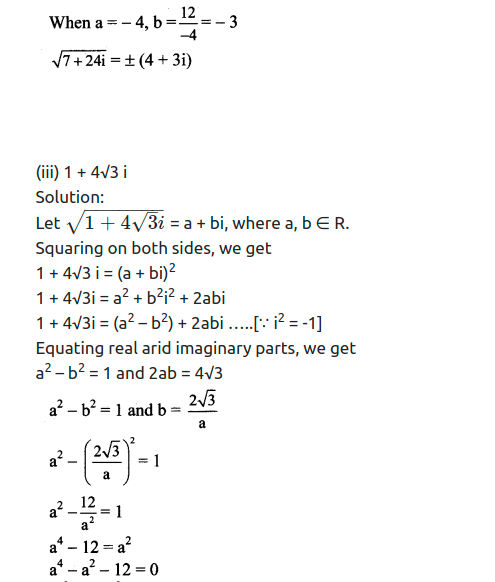

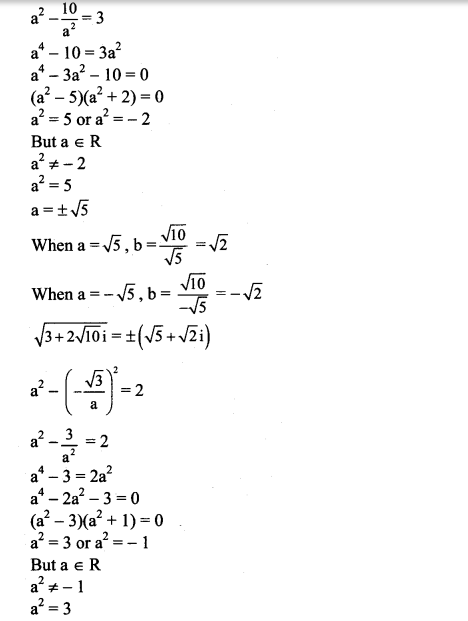
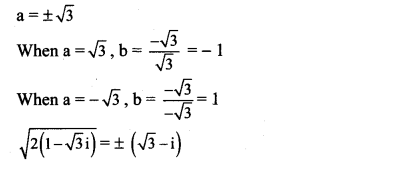

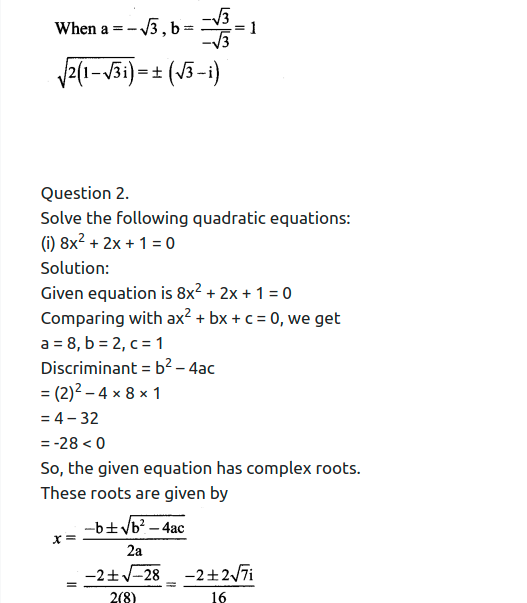

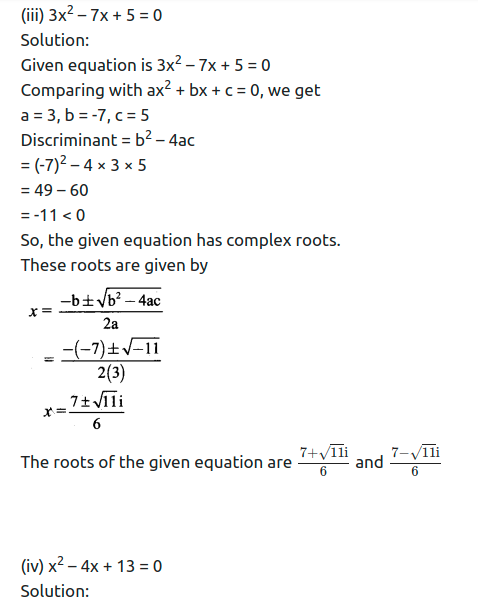
Given equation is x2 – 4x + 13 = 0
Comparing with ax2 + bx + c = 0, we get
a = 1, b = -4, c = 13
Discriminant = b2 – 4ac
= (-4)2 – 4 × 1 × 13
= 16 – 52
= -36 < 0
So, the given equation has complex roots.
These roots are given by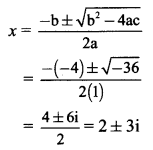
∴ The roots of the given equation are 2 + 3i and 2 – 3i.
Question 3.
Solve the following quadratic equations:
(i) x2 + 3ix + 10 = 0
Solution:
Given equation is x2 + 3ix + 10 = 0
Comparing with ax2 + bx + c = 0, we get
a = 1, b = 3i, c = 10
Discriminant = b2 – 4ac
= (3i)2 – 4 × 1 × 10
= 9i2 – 40
= -9 – 40 ……[∵ i2 = -1]
= -49 < 0
So, the given equation has complex roots.
These roots are given by
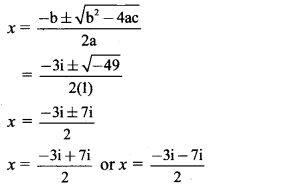
∴ x = 2i or x = -5i
∴ The roots of the given equation are 2i and -5i.
(ii) 2x2 + 3ix + 2 = 0
Solution:
Given equation is 2x2 + 3ix + 2 = 0
Comparing with ax + bx + c = 0, we get
a = 2, b = 3i, c = 2
Discriminant = b2 – 4ac
= (3i)2 – 4 × 2 × 2
= 9i2 – 16
= -9 – 16 …..[∵ i2 = -1]
= -25 < 0
So, the given equation has complex roots.
These roots are given by

∴ The roots of the given equation are 12i and -2i.
(iii) x2 + 4ix – 4 = 0
Solution:
Given equation is x2 + 4ix – 4 = 0
Comparing with ax2 + bx + c = 0, we get
a = 1, b = 4i, c = -4
Discriminant = b2 – 4ac
= (4i)2 – 4 × 1 × (-4)
= 16i2 + 16
= -16 + 16 …..[∵ i2 = -1]
= 0
So, the given equation has equal roots.
These roots are given by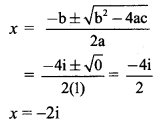
∴ x = -2i
∴ The root of the given equation is -2i.
(iv) ix2 – 4x – 4i = 0
Solution:
ix2 – 4x – 4i = 0
Multiplying throughout by i, we get
i2x2 – 4ix – 4i2 = 0
-x2 – 4ix + 4 = 0 …[∵ i2 = -1]
x2 + 4ix – 4 = 0
Comparing with ax2 + bx + c = 0, we get
a = 1, b = 4i, c = -4
Discriminant = b2 – 4ac
= (4i)2 – 4 × 1 × (-4)
= 16i2 + 16
= -16 + 16
= 0
So, the given equation has equal roots.
These roots are given by
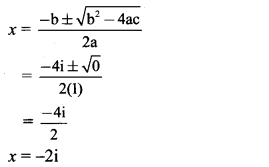
∴ The root of the given equation is -2i
Question 4.
Solve the following quadratic equations:
(i) x2 – (2 + i) x – (1 – 7i) = 0
Solution:
Given equation is x2 – (2 + i)x – (1 – 7i) = 0
Comparing with ax2 + bx + c = 0, we get
a = 1, b = -(2 + i), c = -(1 – 7i)
Discriminant = b2 – 4ac
= [-(2 + i)]2 – 4 × 1 × -(1 – 7i)
= 4 + 4i + i2 + 4 – 28i
= 4 + 4i – 1 + 4 – 28i …..[∵ i2 = – 1]
= 7 – 24i
So, the given equation has complex roots.
These roots are given by

Let 7−24i−−−−−−√ = a + bi, where a, b ∈ R
Squaring on both sides, we get
7 – 24i = a2 + i2b2 + 2abi
7 – 24i = a2 – b2 + 2abi
Equating real and imaginary parts, we get
a2 – b2 = 7 and 2ab = -24

(ii) x2 – (3√2 + 2i) x + 6√2 i = 0
Solution:
Given equation is x2 – (3√2 + 2i) x + 6√2 i = 0
Comparing with ax2 + bx + c = 0, we get
a = 1, b = -(3√2 + 2i), c = 6√2i
Discriminant = b2 – 4ac
= [-(3√2 + 2i)]2 – 4 × 1 × 6√2 i
= 18 + 12√2i + 4i2 – 24√2 i
= 18 – 12√2 i – 4 ……[∵ i2 = -1]
= 14 – 12√2 i
So, the given equation has complex roots.
These roots are given by


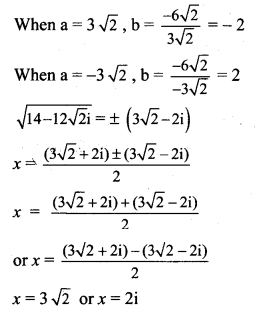
(iii) x2 – (5 – i) x + (18 + i) = 0
Solution:
Given equation is x2 – (5 – i)x + (18 + i) = 0
Comparing with ax2 + bx + c = 0, we get
a = 1, b = -(5 – i), c = 18 + i
Discriminant = b2 – 4ac
= [-(5 – i)]2 – 4 × 1 × (18 + i)
= 25 – 10i + i2 – 72 – 4i
= 25 – 10i – 1 – 72 – 4i ……[∵ i2 = -1]
= -48 – 14i
So, the given equation has complex roots.
These roots are given by
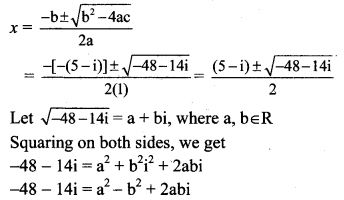
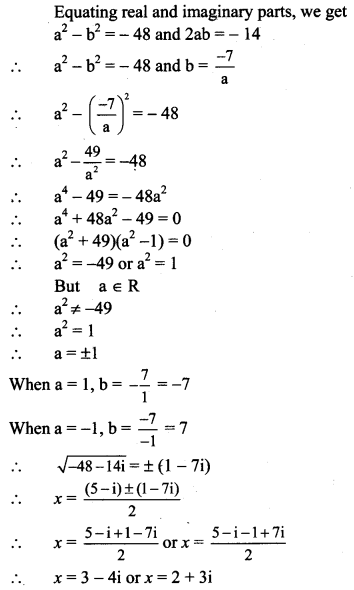
(iv) (2 + i) x2 – (5 – i) x + 2(1 – i) = 0
Solution:
Given equation is (2 + i) x2 – (5 – i) x + 2(1 – i) = 0
Comparing with ax2 + bx + c = 0, we get
a = 2 + i, b = -(5 – i), c = 2(1 – i)
Discriminant = b2 – 4ac
= [-(5 – i)]2 – 4 × (2 + i) × 2(1 – i)
= 25 – 10i + i2 – 8(2 + i) (1 – i)
= 25 – 10i + i2 – 8(2 – 2i + i – i2)
= 25 – 10i – 1 – 8(2 – i + 1) …..[∵ i2 = -1]
= 25 – 10i – 1 – 16 + 8i – 8
= -2i
So, the given equation has complex roots.
These roots are given by
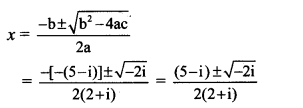
Let −2i−−−√ = a + bi, where a, b ∈ R
Squaring on both sides, we get
-2i = a2 + b2i2 + 2abi
-2i = a2 – b2 + 2abi
Equating real and imaginary parts, we get
a2 – b2 = 0 and 2ab = -2
a2 – b2 = 0 and b = −1a
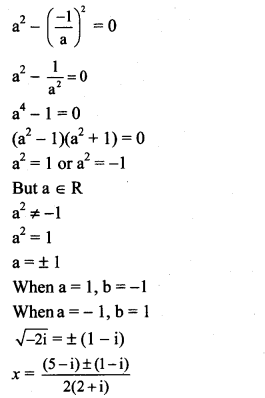

Question 5.
Find the value of
(i) x3 – x2 + x + 46, if x = 2 + 3i
Solution:
x = 2 + 3i
x – 2 = 3i
(x – 2)2 = 9i2
x2 – 4x + 4 = 9(-1) …..[∵ i2 = -1]
x2 – 4x + 13 = 0 …..(i)

Dividend = Divisor × Quotient + Remainder
∴ x3 – x2 + x + 46 = (x2 – 4x + 13) (x + 3) + 7
= 0(x + 3) + 7 …..[from(i)]
= 7
Alternate Method:
x = 2 + 3i
α = 2 + 3i, α¯ = 2 – 3i
αα¯ = (2 + 3i)(2 – 3i)
= 4 – 6i + 6i – 9i2
= 4 – 9(-1)
= 4 + 9
= 13
α + α¯ = 2 + 3i + 2 – 3i = 4
∴ Standard form of quadratic equation,
x2 – (Sum of roots) x + Product of roots = 0
x2 – 4x + 13 = 0
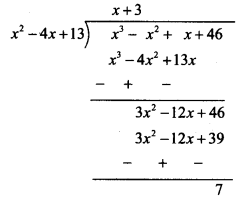
Dividend = Divisor × Quotient + Remainder
∴ x3 – x2 + x + 46 = (x2 – 4x + 13).(x + 3) + 7
= 0(x + 3) + 7 …..[From (i)]
= 7
(ii) 2x3 – 11x2 + 44x + 27, if x = 253−4i
Solution:
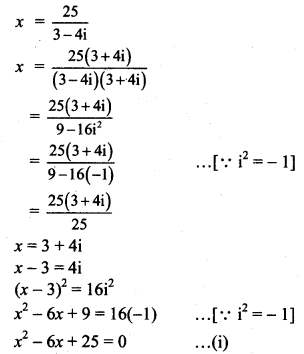
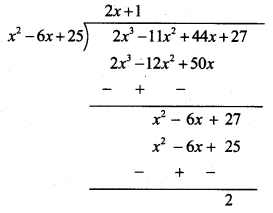
Dividend = Divisor × Quotient + Remainder
2x3 – 11x2 + 44x + 27 = (x2 – 6x + 25)(2x + 1) + 2
= 0.(2x + 1) + 2 …..[From (i)]
= 0 + 2
= 2
(iii) x3 + x2 – x + 22, if x = 51−2i
Solution:
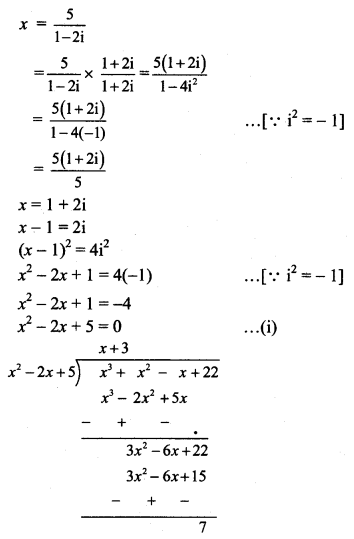
Dividend = Divisor × Quotient + Remainder
x3 + x2 – x + 22 = (x2 – 2x + 5)(x + 3) + 7
= 0.(x + 3) + 7 …..[From (i)]
= 0 + 7
= 7
(iv) x4 + 9x3 + 35x2 – x + 4, if x = -5 + √-4
Solution:
x = -5 + √-4
x + 5 = √-4
x + 5 = √4 √-1
x + 5 = 2i
(x + 5)2 = 4i2
x2 + 10x + 25 = 4(-1) ….[∵ i2 = -1]
x2 + 10x + 29 = 0 …..(i)
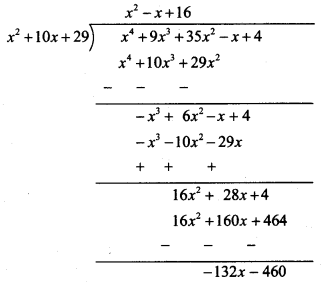
Dividend = Divisor × Quotient + Remainder
x4 + 9x3 + 35x2 – x + 4 = (x2 + 10x + 29) (x2 – x + 16) – 132x – 460
= 0.(x2 – x + 16) – 132x – 460 …..[From (i)]
= -132 (-5 + 2i) – 460
= 660 – 264i – 460
= 200 – 264i
(v) 2x4 + 5x3 + 7x2 – x + 41, if x = -2 – √3i
Solution:
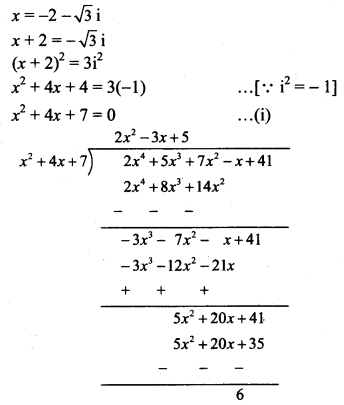
Dividend = Divisor × Quotient + Remainder
2x4 + 5x3 + 7x2 – x + 41 = (x2 + 4x + 7) (2x2 – 3x + 5) + 6
= 0(2x2 – 3x + 5) + 6 ……[From (i)]
= 0 + 6
= 6
Ex 1.3
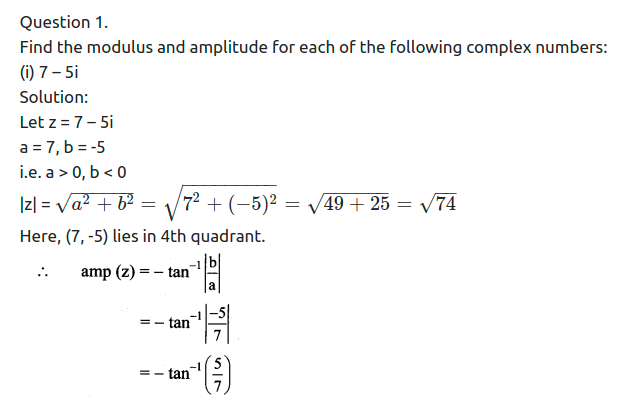
(ii) √3 + √2 i
Solution:
Let z = √3 + √2 i
a = √3, b = √2,
i.e. a > 0, b > 0

(iii) -8 + 15i
Solution:
Let z = -8 + 15i
a = -8, b = 15 , i.e. a < 0, b > 0
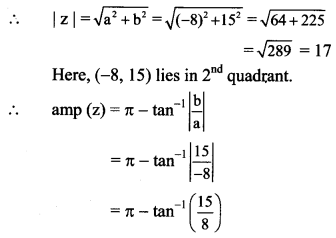
(iv) -3(1 – i)
Solution:
Let z = -3(1 – i) = -3 + 3i
a = -3, b = 3 , i.e. a < 0, b > 0

(v) -4 – 4i
Solution:
Let z = -4 – 4i
a = -4, b = -4 , i.e. a < 0, b < 0
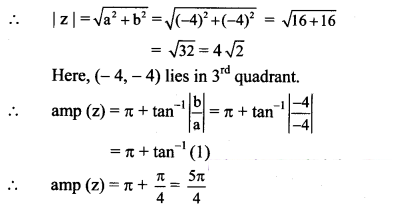
(vi) √3 – i
Solution:
Let z = √3 – i
a = √3, b = -1, i.e. a > 0, b < 0
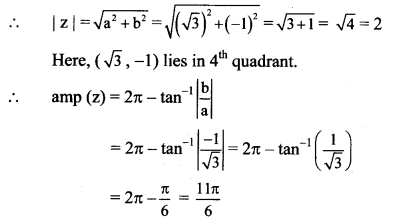
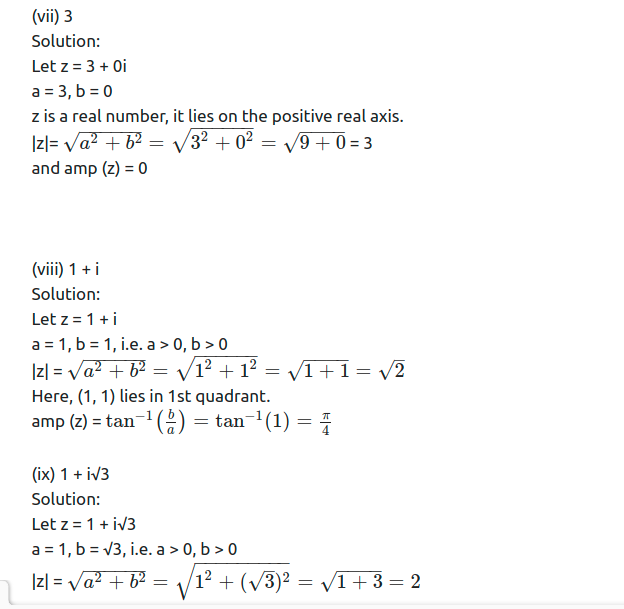

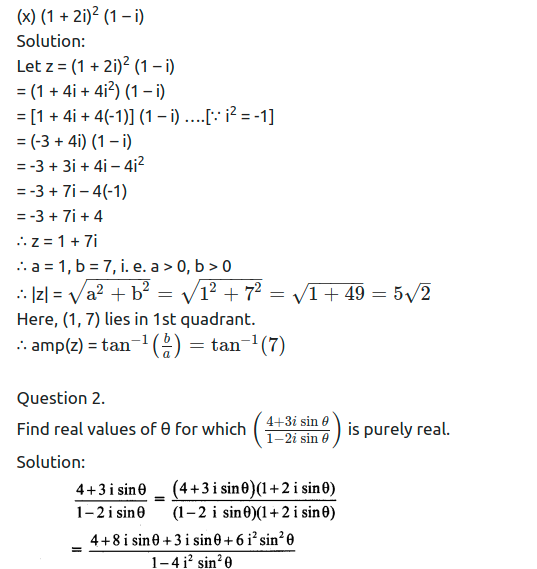

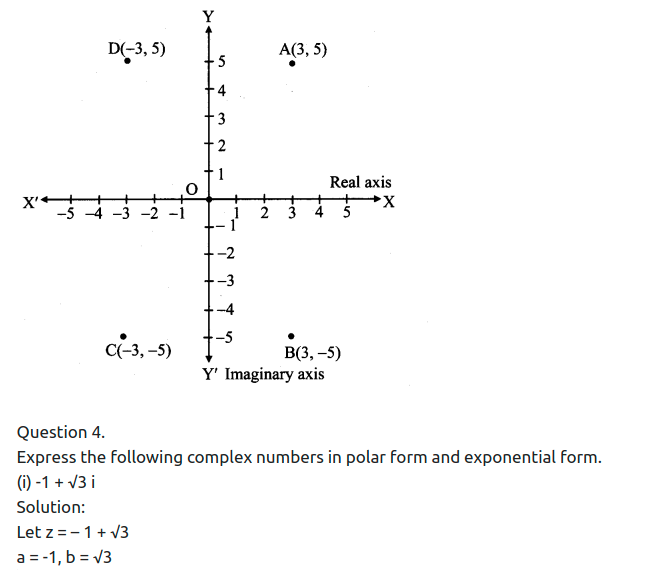
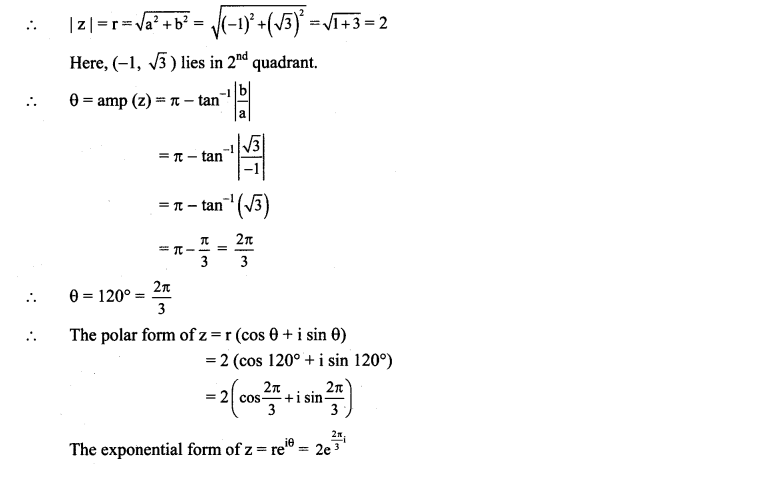
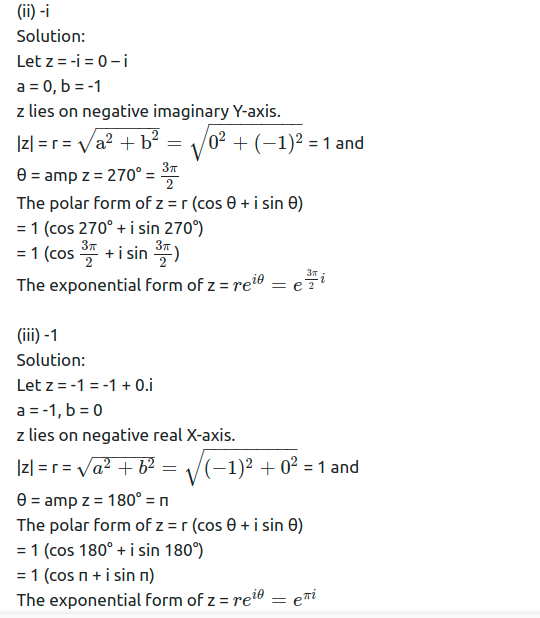
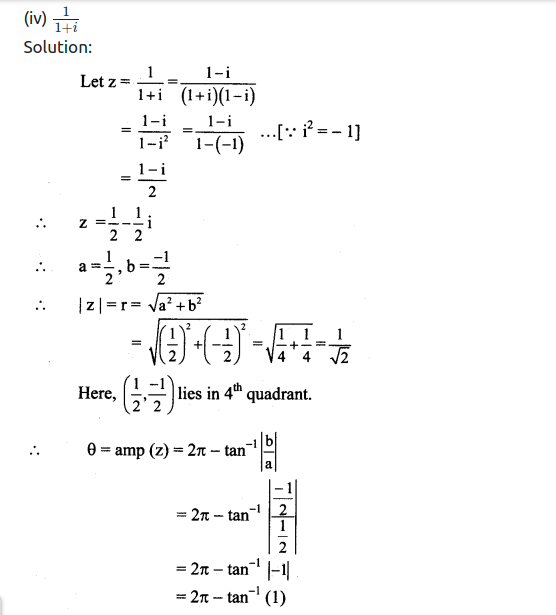
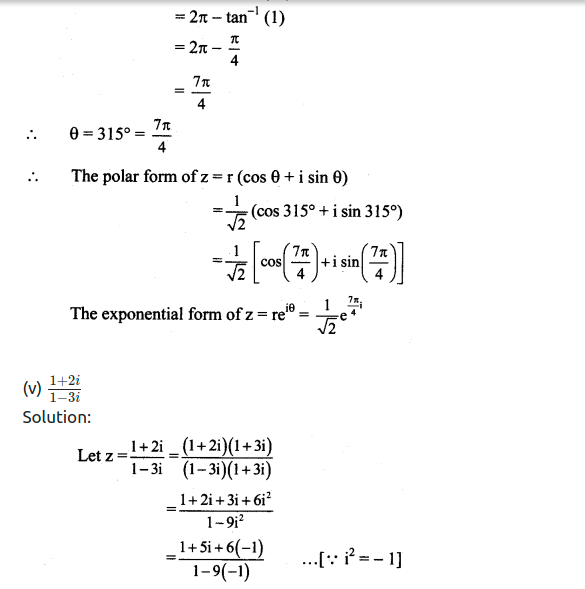
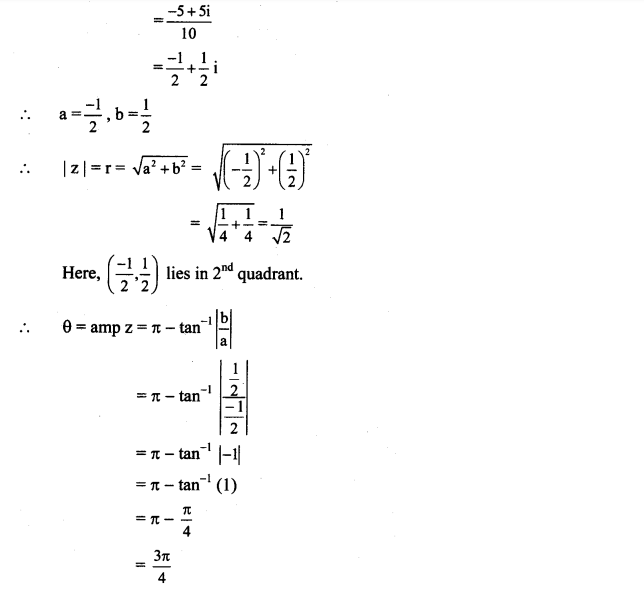
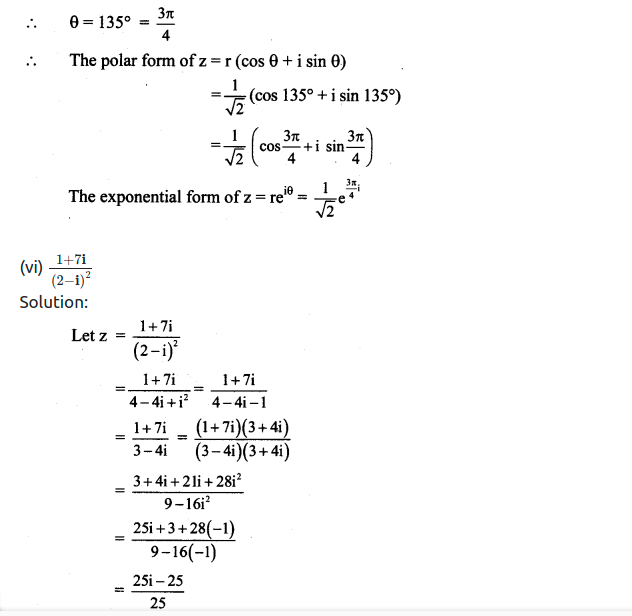
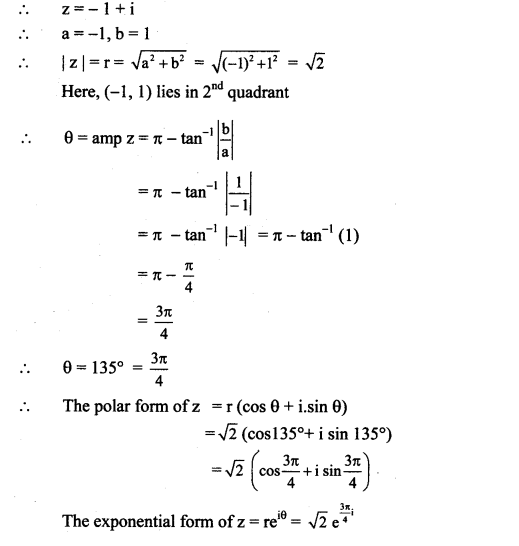


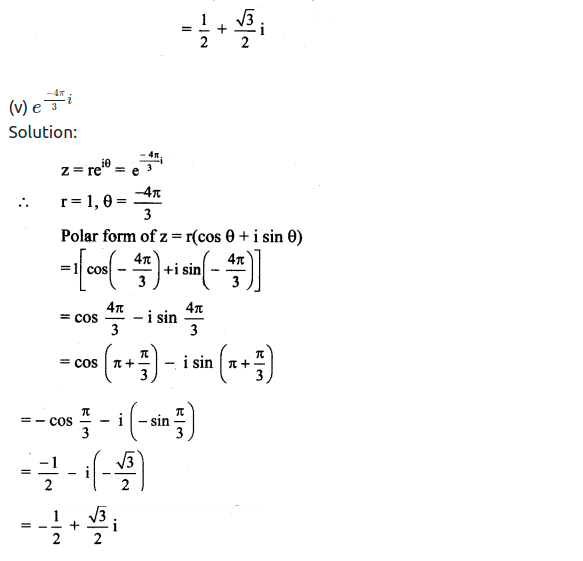
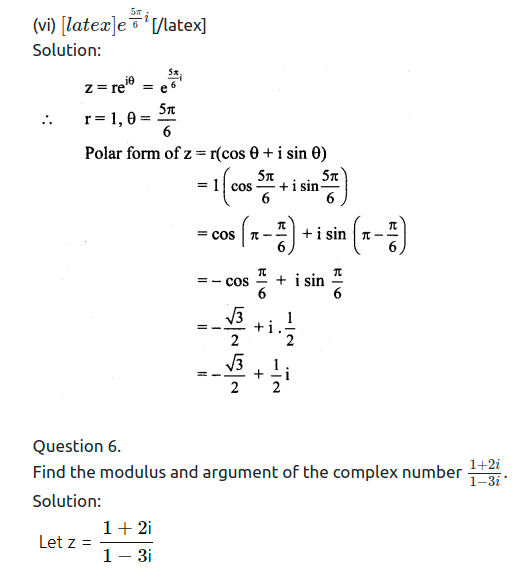
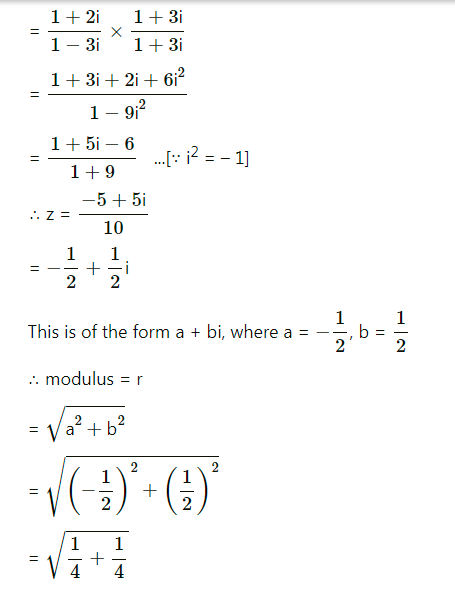
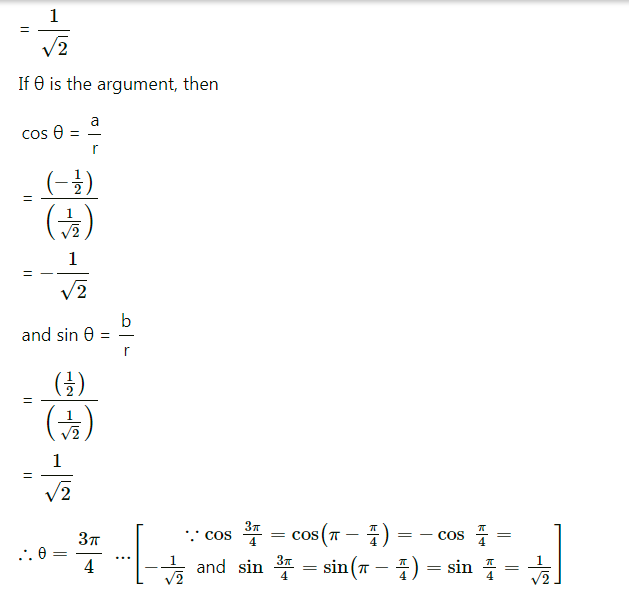
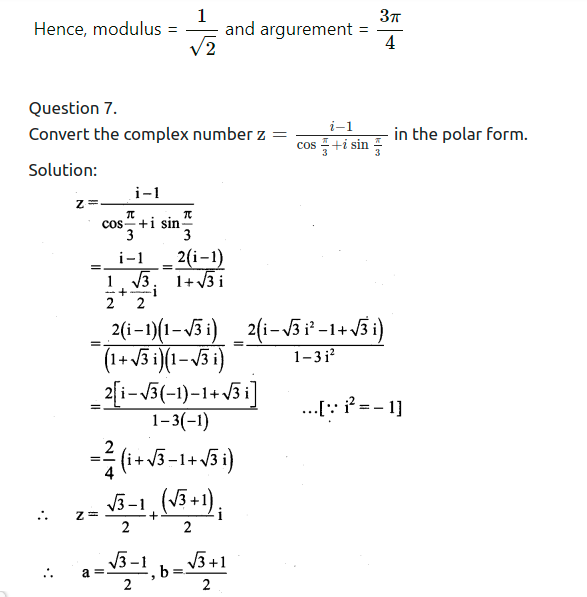
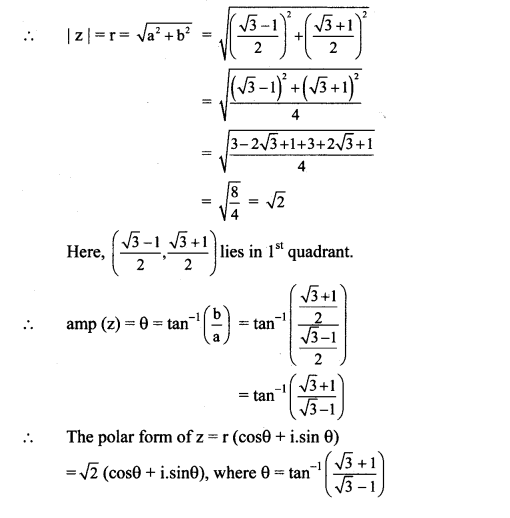
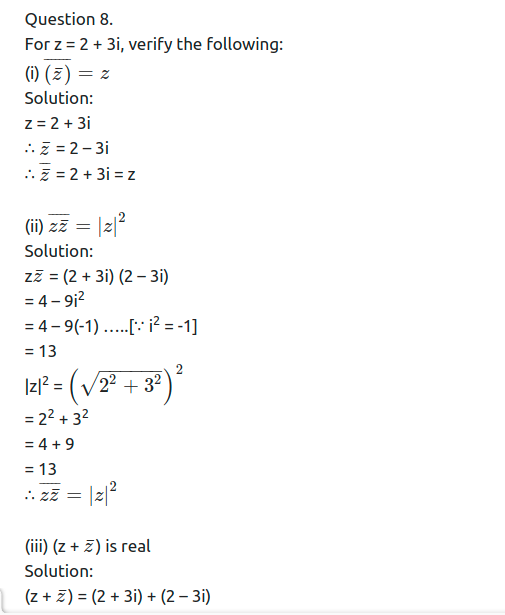
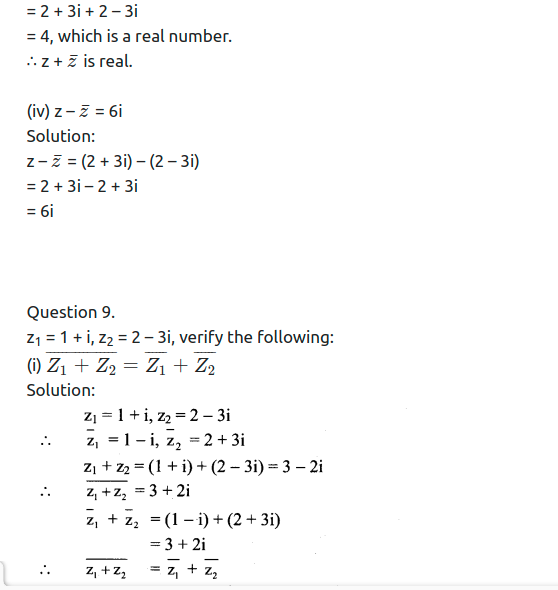
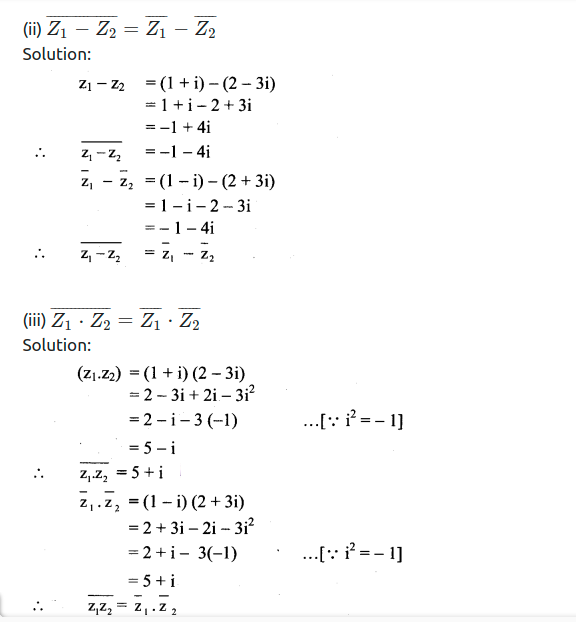
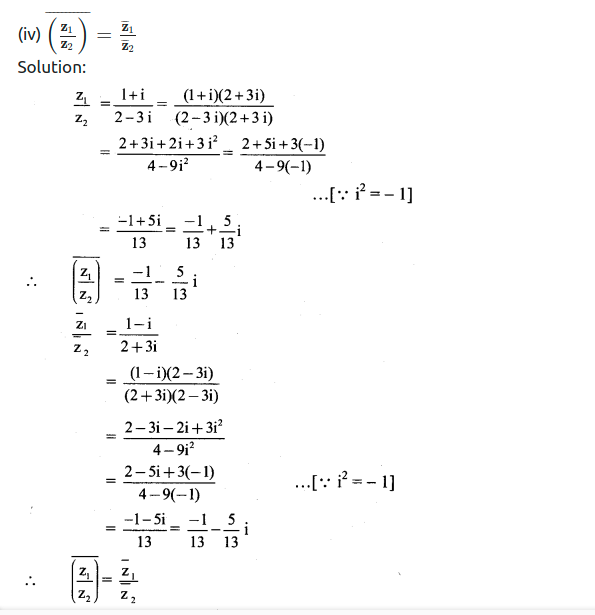
Ex 1.4
Question 1.
Find the value of
(i) ω18
(ii) ω21
(iii) ω-30
(iv) ω-105
Solution:
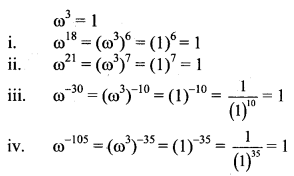
Question 2.
If ω is the complex cube root of unity, show that
(i) (2 – ω)(2 – ω2) = 7
Solution:
ω is the complex cube root of unity.
ω3 = 1 and 1 + ω + ω2 = 0
Also, 1 + ω2 = -ω, 1 + ω = -ω2 and ω + ω2 = -1
L.H.S. = (2 – ω)(2 – ω2)
= 4 – 2ω2 – 2ω + ω3
= 4 – 2(ω2 + ω) + 1
= 4 – 2(-1) + 1
= 4 + 2 + 1
= 7
= R.H.S.
(ii) (1 + ω – ω2)6 = 64
Solution:
ω is the complex cube root of unity.
ω3 = 1 and 1 + ω + ω2 = 0
Also, 1 + ω2 = -ω, 1 + ω = -ω2 and ω + ω2 = -1
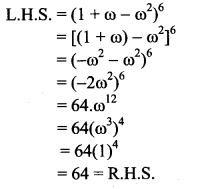
(iii) (1 + ω)3 – (1 + ω2)3 = 0
Solution:
ω is the complex cube root of unity.
ω3 = 1 and 1 + ω + ω2 = 0
Also, 1 + ω2 = -ω, 1 + ω = -ω2 and ω + ω2 = -1
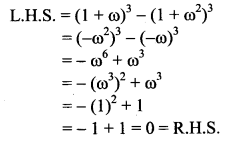
(iv) (2 + ω + ω2)3 – (1 – 3ω + ω2)3 = 65
Solution:
ω is the complex cube root of unity.
ω3 = 1 and 1 + ω + ω2 = 0
Also, 1 + ω2 = -ω, 1 + ω = -ω2 and ω + ω2 = -1

(v) (3 + 3ω + 5ω2)6 – (2 + 6ω + 2ω2)3 = 0
Solution:
ω is the complex cube root of unity.
ω3 = 1 and 1 + ω + ω2 = 0
Also, 1 + ω2 = -ω, 1 + ω = -ω2 and ω + ω2 = -1
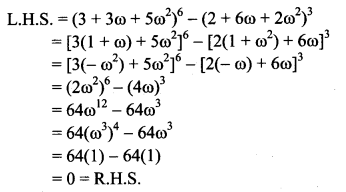
(vi) a+bω+cω2c+aω+bω2 = ω2
Solution:
ω is the complex cube root of unity.
ω3 = 1 and 1 + ω + ω2 = 0
Also, 1 + ω2 = -ω, 1 + ω = -ω2 and ω + ω2 = -1
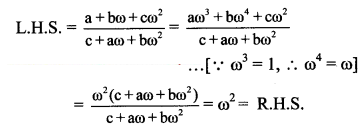
(vii) (a + b) + (aω + bω2) + (aω2 + bω) = 0
Solution:
ω is the complex cube root of unity.
ω3 = 1 and 1 + ω + ω2 = 0
Also, 1 + ω2 = -ω, 1 + ω = -ω2 and ω + ω2 = -1
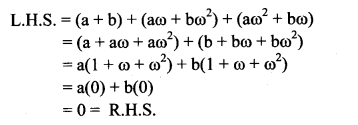
(viii) (a – b)(a – bω)(a – bω2) = a3 – b3
Solution:
ω is the complex cube root of unity.
ω3 = 1 and 1 + ω + ω2 = 0
Also, 1 + ω2 = -ω, 1 + ω = -ω2 and ω + ω2 = -1
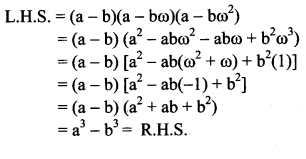
(ix) (a + b)2 + (aω + bω2)2 + (aω2+ bω)2 = 6ab
Solution:
ω is the complex cube root of unity.
ω3 = 1 and 1 + ω + ω2 = 0
Also, 1 + ω2 = -ω, 1 + ω = -ω2 and ω + ω2 = -1
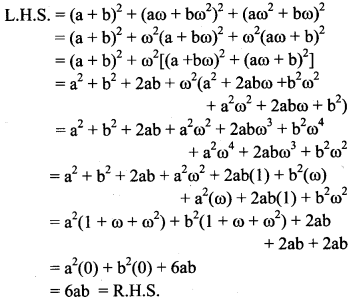
Question 3.
If ω is the complex cube root of unity, find the value of
(i) ω + 1ω
Solution:
ω is the complex cube root of unity.
ω3 = 1 and 1 + ω + ω2 = 0
Also, 1 + ω2 = -ω, 1 + ω = -ω2 and ω + ω2 = -1
ω+1ω=ω2+1ω=−ωω=−1
(ii) ω2 + ω3 + ω4
Solution:
ω is the complex cube root of unity.
ω3 = 1 and 1 + ω + ω2 = 0
Also, 1 + ω2 = -ω, 1 + ω = -ω2 and ω + ω2 = -1
ω2 + ω3 + ω4
= ω2(1 + ω + ω2)
= ω2(0)
= 0
(iii) (1 + ω2)3
Solution:
ω is the complex cube root of unity.
ω3 = 1 and 1 + ω + ω2 = 0
Also, 1 + ω2 = -ω, 1 + ω = -ω2 and ω + ω2 = -1
(1 + ω2)3
= (-ω)3
= -ω3
= -1
(iv) (1 – ω – ω2)3 + (1 – ω + ω2)3
Solution:
ω is the complex cube root of unity.
ω3 = 1 and 1 + ω + ω2 = 0
Also, 1 + ω2 = -ω, 1 + ω = -ω2 and ω + ω2 = -1
(1 – ω – ω2)3 + (1 – ω + ω2)3
= [1 – (ω + ω2)]3 + [(1 + ω2) – ω]3
= [1 – (-1)]2 + (-ω – ω)3
= 23 + (-2ω)3
= 8 – 8ω3
= 8 – 8(1)
= 0
(v) (1 + ω)(1 + ω2)(1 + ω4)(1 + ω8)
Solution:
ω is the complex cube root of unity.
ω3 = 1 and 1 + ω + ω2 = 0
Also, 1 + ω2 = -ω, 1 + ω = -ω2 and ω + ω2 = -1
(1 + ω)(1 + ω2)(1 + ω4)(1 + ω8)
= (1 + ω)(1 + ω2)(1 + ω)(1 + ω2) …..[∵ ω3 = 1, ω4 = ω]
= (-ω2)(-ω)(-ω2)(-ω)
= ω6
= (ω3)2
= (1)2
= 1
Question 4.
If α and β are the complex cube roots of unity, show that
(i) α2 + β2 + αβ = 0
(ii) α4 + β4 + α-1β-1 = 0
Solution:
α and β are the complex cube roots of unity.
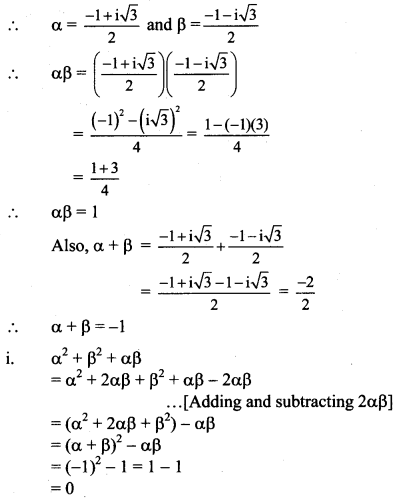
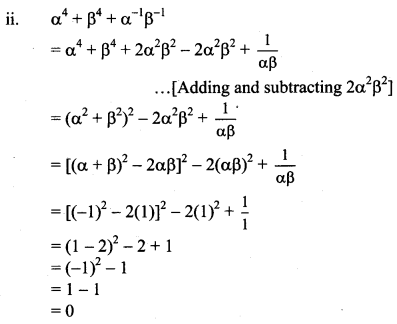
Question 5.
If x = a + b, y = αa + βb and z = aβ + bα, where α and β are complex cube roots of unity, show that xyz = a3 + b3.
Solution:
x = a + b, y = αa + βb, z = aβ + bα
α and β are the complex cube roots of unity.
∴ α = −1+i3√2 and β = −1−i3√2
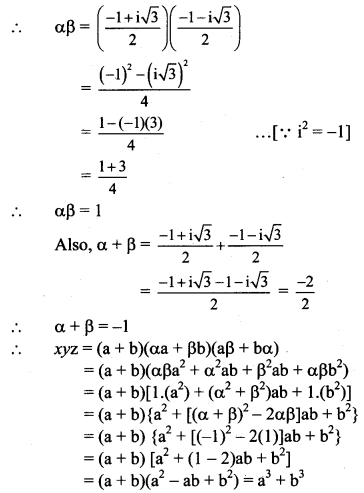
Question 6.
Find the equation in cartesian coordinates of the locus of z if
(i) |z| = 10
Solution:
Let z = x + iy
|z| = 10
|x + iy| = 10
x2+y2−−−−−−√ = 10
∴ x2 + y2 = 100
(ii) |z – 3| = 2
Solution:
Let z = x + iy
|z – 3| = 2
|x + iy – 3| = 2
|(x – 3) + iy| = 2
(x−3)2+y2−−−−−−−−−−−√ = 2
∴ (x – 3)2 + y2 = 4
(iii) |z – 5 + 6i| = 5
Solution:
Let z = x + iy
|z – 5 + 6i| = 5
|x + iy – 5 + 6i| = 5
|(x – 5) + i(y + 6)| = 5
(x−5)2+(y+6)2−−−−−−−−−−−−−−−√ = 5
∴ (x – 5)2 + (y + 6)2 = 25
(iv) |z + 8| = |z – 4|
Solution:
Let z = x + iy
|z + 8| = |z – 4|
|x + iy + 8| = |x + iy – 4|
|(x + 8) + iy | = |(x – 4) + iy|
(x+8)2+y2−−−−−−−−−−−√=(x−4)2+y2−−−−−−−−−−−√
(x + 8)2 + y2 = (x – 4)2 + y2
x2 + 16x + 64 + y2 = x2 – 8x + 16 + y2
16x + 64 = -8x + 16
24x + 48 = 0
∴ x + 2 = 0
(v) |z – 2 – 2i | = |z + 2 + 2i|
Solution:
Let z = x + iy
|z – 2 – 2i| = |z + 2 + 2i|
|x + iy – 2 – 2i | = |x + iy + 2 + 2i |
|(x – 2) + i(y – 2)| = |(x + 2) + i(y + 2)|
(x−2)2+(y−2)2−−−−−−−−−−−−−−−√=(x+2)2+(y+2)2−−−−−−−−−−−−−−−√
(x – 2)2 + (y – 2)2 = (x + 2)2 + (y + 2)2
x2– 4x + 4 + y2 – 4y + 4 = x2 + 4x + 4 + y2 + 4y + 4
-4x – 4y = 4x + 4y
8x + 8y = 0
x + y = 0
y = -x
(vi) |z+3i||z−6i|=1
Solution:
Let z = x + iy
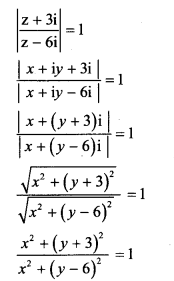
x2 + (y + 3)2 = x2 + (y – 6)2
y2 + 6y + 9 = y2 – 12y + 36
18y – 27 = 0
2y – 3 = 0
Question 7.
Use De Moivre’s theorem and simplify the following:
(i) (cos2θ+isin2θ)7(cos4θ+isin4θ)3
Solution:
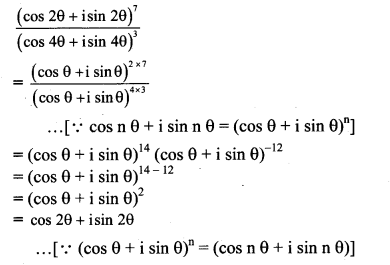
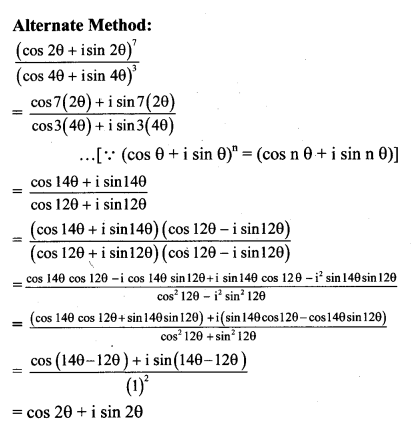
(ii) cos5θ+isin5θ(cos3θ−isin3θ)2
Solution:
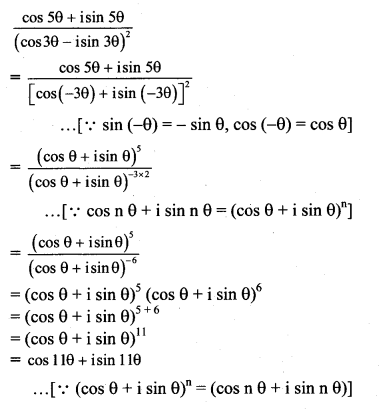
(iii) (cos7π13+isin7π13)4(cos4π13−isin4π13)6
Solution:

Question 8.
Express the following in the form a + ib, a, b ∈ R, using De Moivre’s theorem.
(i) (1 – i)5
Solution:
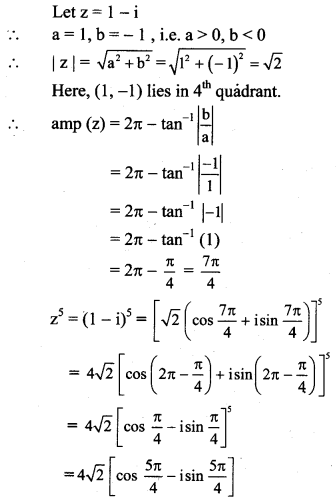
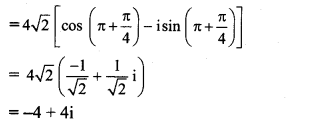
(ii) (1 + i)6
Solution:
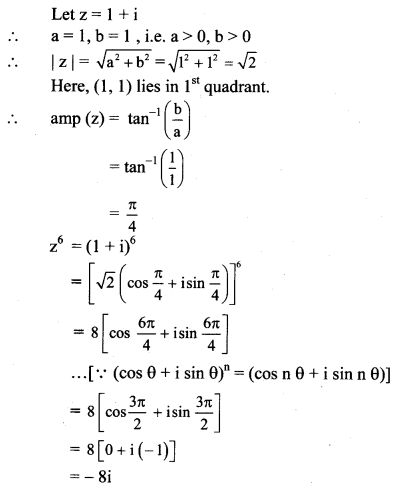
(iii) (1 – √3 i)4
Solution:
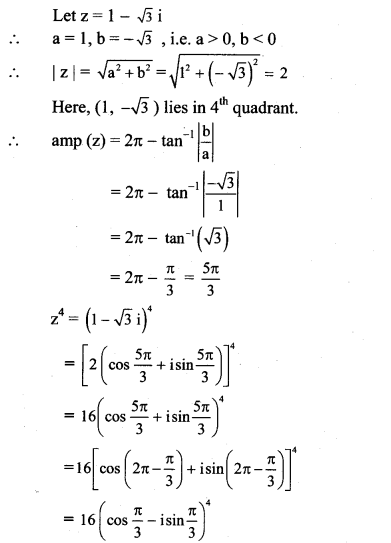

(iv) (-2√3 – 2i)5
Solution:
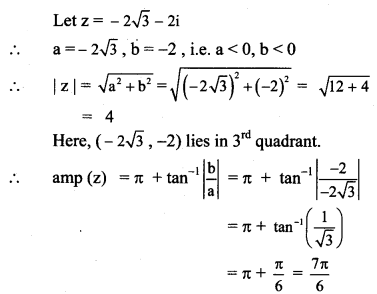
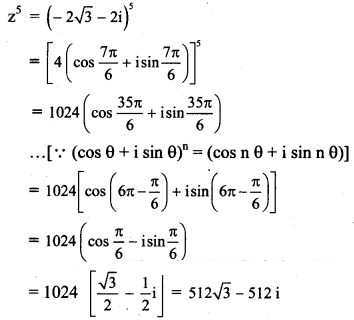
Download PDF
Maharashtra Board Solutions Class 11-Arts & Science Maths (Part 2): Chapter 1- Complex Numbers
Chapterwise Maharashtra Board Solutions Class 11 Arts & Science Maths (Part 2) :
- Chapter 1- Complex Numbers
- Chapter 2- Sequences and Series
- Chapter 3- Permutations and Combination
- Chapter 4- Methods of Induction and Binomial Theorem
- Chapter 5- Sets and Relations
- Chapter 6- Functions
- Chapter 7- Limits
- Chapter 8- Continuity
- Chapter 9- Differentiation
FAQs
You can download the Maharashtra State Board Books from the eBalbharti official website, i.e. cart.ebalbharati.in or from this article.
Students can get the Maharashtra Books for primary, secondary, and senior secondary classes from here. You can view or download the Maharashtra State Board Books from this page or from the official website for free of cost. Students can follow the detailed steps below to visit the official website and download the e-books for all subjects or a specific subject in different mediums.
Step 1: Visit the official website ebalbharati.in
Step 2: On the top of the screen, select “Download PDF textbooks”
Step 3: From the “Classes” section, select your class.
Step 4: From “Medium”, select the medium suitable to you.
Step 5: All Maharashtra board books for your class will now be displayed on the right side.
Step 6: Click on the “Download” option to download the PDF book.
As of now, the MSCERT and Balbharti are responsible for the syllabus and textbooks of Classes 1 to 8, while Classes 9 and 10 are under the Maharashtra State Board of Secondary and Higher Secondary Education (MSBSHSE).
The Maharashtra State Board of Secondary & Higher Secondary Education, conducts the HSC and SSC Examinations in the state of Maharashtra through its nine Divisional Boards located at Pune, Mumbai, Aurangabad, Nasik, Kolhapur, Amravati, Latur, Nagpur and Ratnagiri.
About Maharashtra State Board (MSBSHSE)
The Maharashtra State Board of Secondary and Higher Secondary Education or MSBSHSE (Marathi: महाराष्ट्र राज्य माध्यमिक आणि उच्च माध्यमिक शिक्षण मंडळ), is an autonomous and statutory body established in 1965. The board was amended in the year 1977 under the provisions of the Maharashtra Act No. 41 of 1965.
The Maharashtra State Board of Secondary & Higher Secondary Education (MSBSHSE), Pune is an independent body of the Maharashtra Government. There are more than 1.4 million students that appear in the examination every year. The Maha State Board conducts the board examination twice a year. This board conducts the examination for SSC and HSC.
The Maharashtra government established the Maharashtra State Bureau of Textbook Production and Curriculum Research, also commonly referred to as Ebalbharati, in 1967 to take up the responsibility of providing quality textbooks to students from all classes studying under the Maharashtra State Board. MSBHSE prepares and updates the curriculum to provide holistic development for students. It is designed to tackle the difficulty in understanding the concepts with simple language with simple illustrations. Every year around 10 lakh students are enrolled in schools that are affiliated with the Maharashtra State Board.
Read More
IndCareer Board Book Solutions App
IndCareer Board Book App provides complete study materials for students from classes 1 to 12 of Board. The App contains complete solutions of NCERT books, notes, and other important materials for students. Download the IndCareer Board Book Solutions now.

